(Get free painting tips and plein air painting techniques sent straight to your inbox or on my social media.)
Paint is expensive, so if you want to keep your leftover oil paint overnight for use another day, it is important to find a method to stop oil paint from drying out, and keep your leftover oil paint wet.
At the end of your painting session, don’t scrape your palette and throw the leftover oil paint away. You can leave the clean paint piles where they are, then scrape and dirty areas into several gray piles of different saturations, hues, and values. These gray piles are excellent for making your highly saturated areas pop out. Leave them on your palette with the clean paint piles, this will save you time on your next painting session because you won’t have to put them all back on your palette.
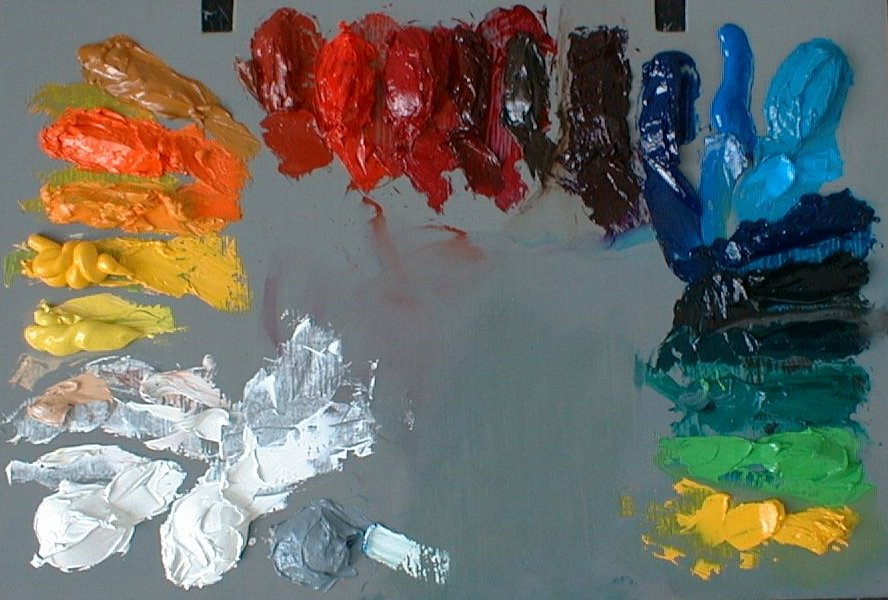
Here are several methods for saving your leftover oil paint, and the pros and cons of each approach.
Method #1: Put your palette in the freezer
The simplest way for saving your leftover oil paint from drying out is to use your freezer. Just put your palette in your freezer at the end of the day! The cold temperature will slow down the rate of oxidation and evaporation, and so help prevent your leftover oil paint from drying out. See method #5 for a variation on this tip.
This method is even more convenient if you have a pochade box or plein air easel that will fit in the freezer compartment. Then you don’t have to mess around with trying to remove a palette from your box.
I am using a Daytripper easel and it just fits in a standard fridge.
Note that the freezing point of linseed oil (the main oil in most oil paints) is -20°C (-4°F). Most people set their freezers at -18C (0°F) , so oil paint will not freeze in most home freezers.
Pros:
- This is the fastest and most convenient method
Cons:
- The owner of the kitchen might shout at you 🙂
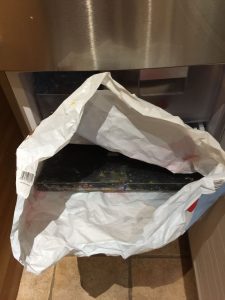
Method #2: Put your palette under water
Step 1: Another method for saving leftover oil paint and stop them drying out, is to put your palette under water. Do this so that the water completely covers your piles of paint. You have to have a water tray large enough to put your complete palette in.
Pros:
- This completely cuts off the oxygen to the paint, and is a good way for how to keep oil paint wet.
Cons:
- After about a week, a slime starts to grow in the water. You will have to clean this slime off your palette and off the piles of paint before you start painting.
- It won’t work if you have a wooden palette. The palette will eventually rot, or warp.
- Exposing an oil painting to water or high humidity can disrupt the cross-linking of the polymers. This can cause a loss of adhesion (which is naturally poor because linseed oil is not a strong adhesive).
Method #3: Transfer your leftover oil paint to a plastic box with compartments and add water
A third method for keeping leftover oil paint from drying out is to transfer it from your palette to boxes. You can find very cheap small plastic boxes that are used for putting sewing supplies in, or a fishing tackle box. These are plastic boxes with small separate compartments that will exclude a lot of the air and prevent the oil paint from drying out. You can use a different compartment for each color.
Step 1: Scrape each color off your palette into a separate compartment of the box.
Step 2: Pour water into the compartments in the box to completely cover the piles of paint.
Pros:
- This completely cuts off the oxygen to the paint, and your paint will never dry out
- The box is small and so particularly when traveling this is easier than carrying around a large plastic water tray.
Cons:
- It takes a lot more time to scrape all your paint into the box and then back onto your palette again the next day compared with the other two methods.
- Exposing an oil painting to water or high humidity can disrupt the cross-linking of the polymers. This can cause a loss of adhesion (which is naturally poor because linseed oil is not a strong adhesive).
Method #4: Put plastic wrap on your palette
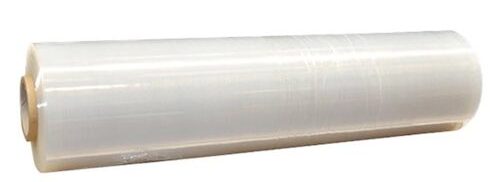
The fourth method for keeping leftover oil paints on your palette is:
Step 1: Can cut piece of plastic wrap a little larger than your palette, and lay it on top of your paints.
Step 2: Gently press the plastic around your piles of paint to exclude all the air
Pros:
- This method does not suffer from the problems of damage to the paint by water.
Cons:
- It is very messy to get the plastic off the paint before you start to work again.
- You actually waste quite a lot of paint because it sticks to the plastic
- It wastes plastic!
Method #5: Plastic wrap and freeze
Here’s a great tip from one of my students for how to keep your leftover oil paint from drying out. It is a combination of methods 1 and 4.
Step 1: Cut a piece of plastic wrap a little larger than your palette, and lay it on top of your paints.
Step 2: Gently press the plastic around your piles of paint to exclude all the air
Step 3: Put the palette in the freezer as in Method 1
Step 4: Take the plastic wrap off BEFORE everything thaws out. There is a minimum loss of paint this way!
Pros:
- You waste much less paint using this method compared to method #4.
Method #6: Use Clove Oil
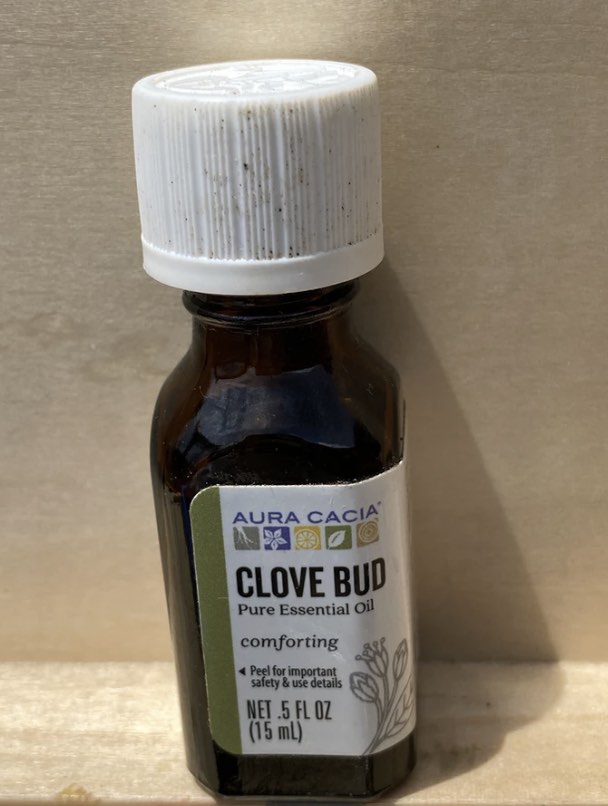
You can use clove oil to increase the drying time. There are two ways of using it:
- Add one or two drops to each pile of leftover oil paint – this works best if you put out very large piles of paint.
- Add a few drops of the clove oil to something absorbent (furniture felt pads, small sponges, cotton ball), then enclose the palette in an airtight container. The fumes from the clove oil will slow the drying of the oil paint.
A great suggestion by Kathy was to stick the furniture felt pads to the lid of your airtight container. Juette uses a 2 1/2″ deep, 14″ x 28″ aluminum baking tray to cover the palette. Great tips from our students!
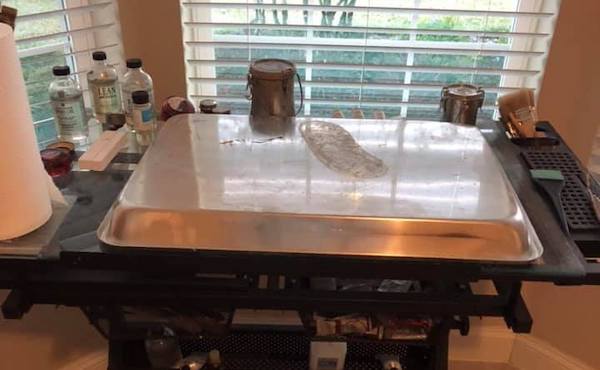
Method #7: Spray Linseed Oil On Your Paint
You can spray a thin film of linseed oil over the paint and then cover it loosely with plastic sheet.
Cons:
- this will change the consistency of your paint a little, and affect your fat over lean working method somewhat. See wikipedia article on fat over lean.
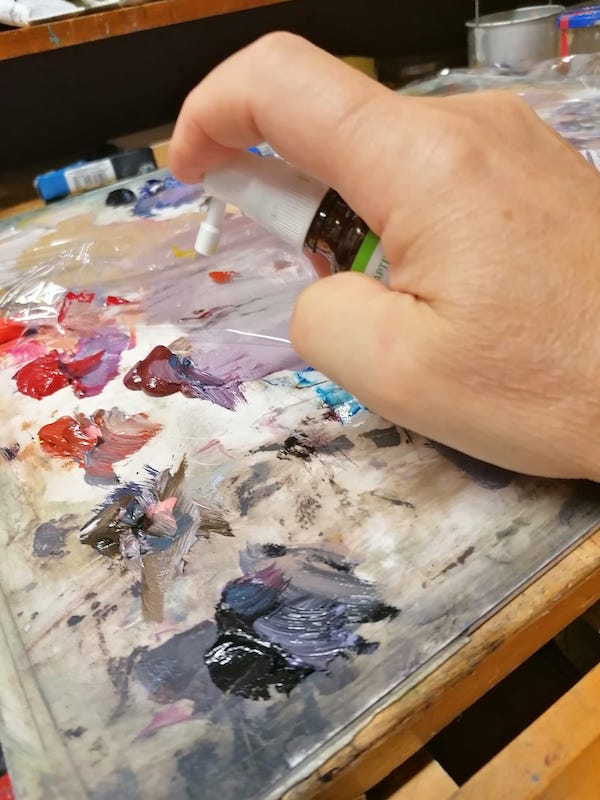
Method #8: Build A Vacuum Chamber
You oil paint won’t dry out in a vacuum chamber. Here’s how to build on:
Tip: Weight Considerations When Painting Plein Air
When I go out plein air painting, I don’t carry paint tubes with me – they are far too heavy. Instead, I put out plenty of paint on my palette. It saves weight and it helps me concentrate on my painting instead of wasting time continually squeezing out paint. But what to do with all that paint at the end of the day? Just use one of the above methods and you’ll keep the oil paint from drying out and be able to use the paint the next day.
Frequently Asked Questions
Can Oil Paint Freeze?
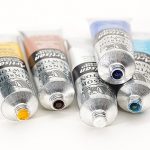
Oil paint can freeze if you lower the temperature enough. However the freezing point of linseed oil (the most commonly used oil in oil paints) is -20°C (-4°F). Since domestic freezers at usually set at 0°F, the oil paint will not freeze in most home freezers. So freezing oil paint is not likely to happen.
Can I Put Oil Paint Under Water? Does Water Ruin Oil Paint?
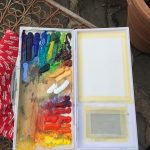
Exposing leftover oil paint to water or high humidity can damage the paint, because it can disrupt the cross-linking of polymers. This can prevent the paint from sticking to the canvas as as linseed oil is already not a strong adhesive.
Also if you store paint or a palette under water, the high humidity can inhibit polymer cross-linking and weaken the paint. There are also chemical reactions that can break the polymer chains in oils. The most common is a chemical reaction with water. This reaction is usually slow, but it gets much faster if the paint film is exposed to humid air under alkaline conditions. This becomes a problem if the paint is formulated with alkaline pigments or if it is applied over an alkaline surface.”
However there is a long artistic tradition of doing this including many professional artists, so if the time under water is relatively short this is probably not be a major problem. However be aware that it could be.
You Might Also Be Interested In
Thank You
Thank you for taking the time to watch this video. I hope you find it useful. If you would like to get free painting tips by email, please sign up for my free tips newsletter.
If you are interested in a structured approach for learning how to paint, take a look at my online painting classes.
Happy painting!
Barry John Raybould
Virtual Art Academy
What The Students Are Saying
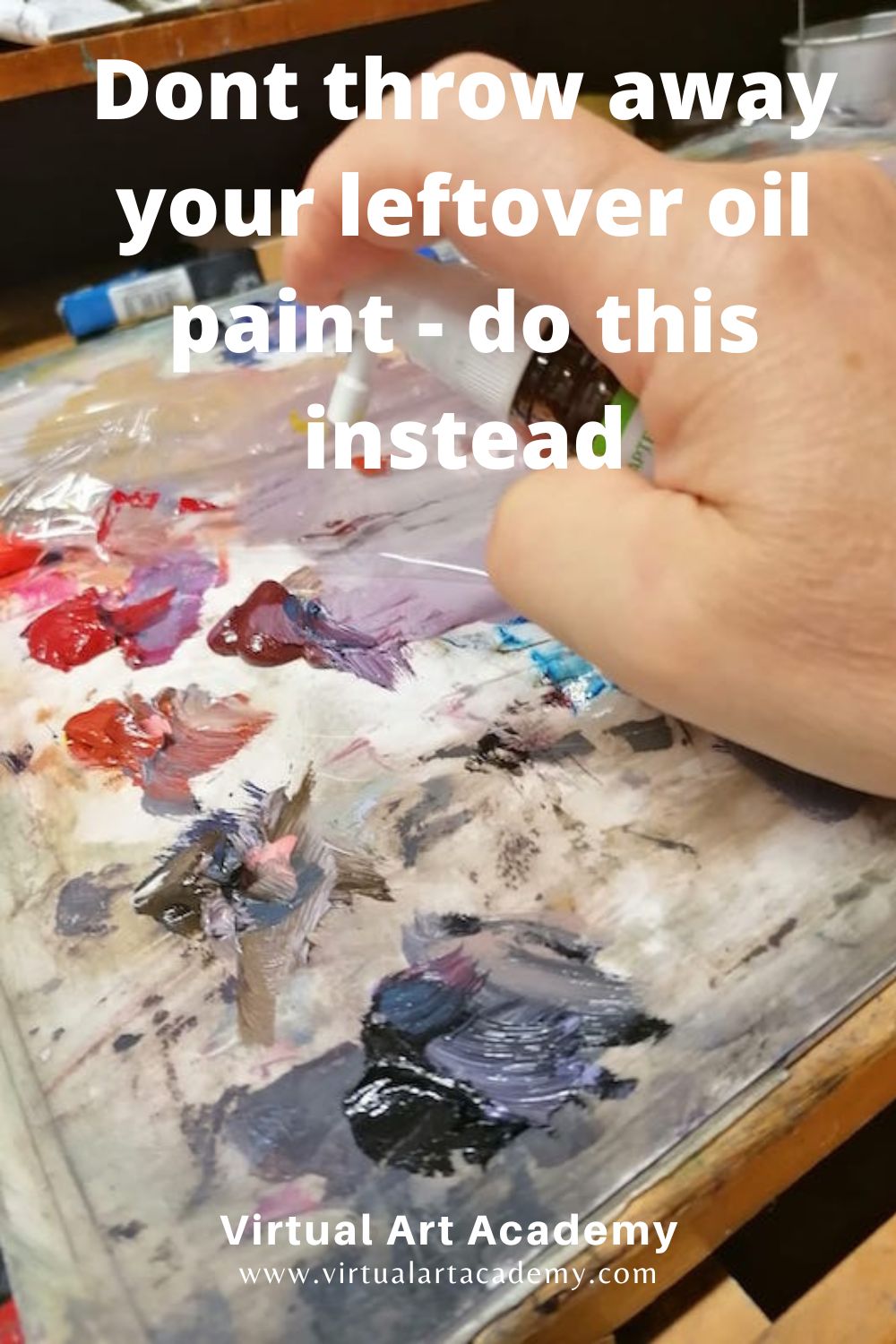
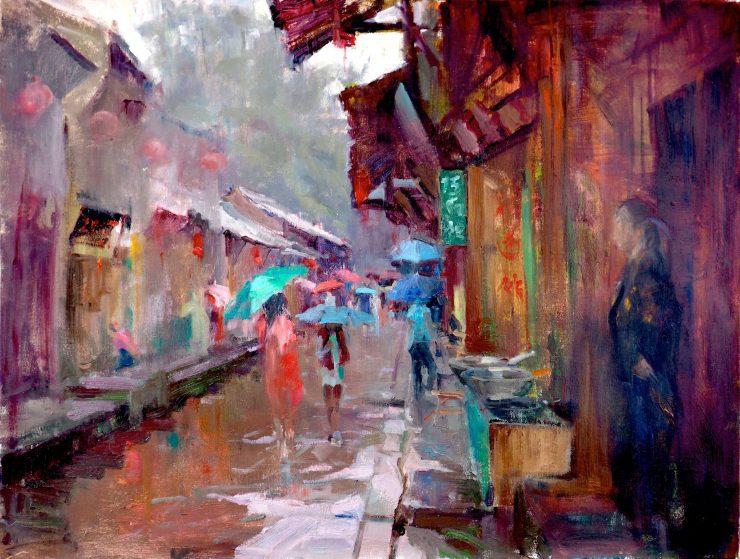




















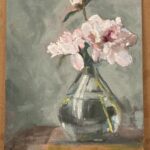




Paint often comes in aluminum tubes. You can use pieces of aluminum foil and fold it around each pile of paint. It will be airtight. Just unfold it whenever you’re ready to use it again.
That is a great idea for saving oil paint from drying out. It is probably easier to manage than plastic wrap in terms of scraping the paint off.
Great suggestions! When using clove oil, how long does it take for the paints to dry thoroughly? I’ve been using a drop on a folded paper towel in my sealed palette, and it does definitely keep the oils pliable. But it seems to also keep the oil paint from drying on my canvas! And it’s water mixable oils, at that. Any idea on how long it will take to dry on the canvas? Thanks so much
I haven’t tried it with water soluble oils, so I don’t have any experience to share with you on that, sorry.
I use a variation of the above: I scoop my paint off the palette and transfer them onto a small piece of tile, then put it in a small plastic box with lid, and throw it into my freezer. The wife won’t shout at me for occupying too much freezer space, and I can keep my paint fresh for up to a month.
Does the freezer method work with water mixable oils (I am using Winsor Newton’s Artisan)? I have tried keeping water on them, sealing the palette in a ziploc bag, wrapping palette in plastic wrap, but have not found a method yet that keeps them from getting gloopy and stringy. I am working on a very large commission and keep having to mix new colors that should be the same but by the time I get there, my mixed paint is too gloopy/stringy to use.
yes Christi, if you put them in the freezer it should stop your oil paints drying out. The clove oil method is worth trying too.
Thanks so much for your response! I have clove oil, but don’t really want my painting to smell like cloves. I will try the freezer method.
Spray the paint with WD-40….it works. No freezing necessary and it doesn’t affect the paint.
I’m can’t see how this would not affect the paint. In general you never want to mix a non-drying oil with your oil paints. If you do, a part of your oil painting will never dry.
this is helpful, what about putting your palette in an airtight box for acrylics (Masterson’s) with some clove oil will that work?
that should work
Another one: put palette in a vacuum box. Sucking out all the air should disrupt the drying process
What is a vacuum box?
I’ve added method # 8 for how to stop oil paints drying out using a vacuum box. This explains how to make a vacuum box. I might have a go at this myself. Looks like a good system for stopping your oil paint from drying out on the palette if you’ve got a good plumber friend to help you.
I’ve put paint into lidded containers, work it level, add enough white refined linseed oil to cover the surface to prevent skinning over. When ready to paint again pour off the white refined linseed oil from the surface .
Great information. Thank you. For those who use Water Soluble Oils, I spray a fine mist of water over my paints on my glass palette and then cover it with aluminum foil, gently pressing the foil around the piles of paint to exclude the air. When I come back each day to remove the foil, a bit of oil paint lifts off the top of each pile, but that is OK. It is usually the “skin” that comes off and exposes fresh paint underneath. At the end of each painting session, I place the same piece of foil back over the palette lining up with each pile as before. The paint that had lifted off is still on the foil and then rests back on top of each pile on the palette. This further helps to “seal” each pile and keep them fresh. I can usually get 7-to-10 days out of my paint this way.
I plein air paint and travel frequently with a small paint box which carries 6 x 8 inch panels. I need small amounts of paint to make it light weight and fit airline standards for small luggage. I can’t carry my 6 colors in tubes Turp and brushes. Here is what I do,
I ama woman and have acquired a collection of makeup, eye ream face cream jars. These jars are usually glass or double lined plastic, meaning plastic jar with space for air and plastic lining, with Uber expensive crème Inside. These jars are made to keep these fragile crèmes from drying out. Ask the women in your life to gift you these jars. Start your plein air day with filled paint in these, then scrape left over paint I to them end of day.
Also, they sail right through airline scanners carry on in my makeup bag! ( but that means I go bare minimum in the glam department) on trip. Oh well, plan your fluids well in these cases. I also use larger cosmetic and. Crème jars in the studio. PAINT SAVES IN THESE Forever,!!!!
I just clean my palette out after each usage and place the paint into a container. As long as I use the paint everyday (add a little medium at times (non linseed oils of course)) it usually last a week. Of course, it is time consuming, some paint dries quicker than others and I have to make sure I don’t mix the paints. Might add this to freezer next time.
I buy the small plastic “sample” cups at Costco that they use to pass out food samples. One cup fits over each paint pile on my palette and seals the paint in place. They can be used over and over until the edges are no longer clean then replace. No muss no fuss.
I have tried these and not found them as good as the plastic wrap or freezer method. The problem is that there is still quite a lot of air near the paint. They may work better in colder damper climates perhaps but my experience in hot climates is that they don’t slow the drying by very much.
Great idea
I heard this just when I needed to hear it. I’m in the market for a standalone freezer and was going to get the smallest one available. Now I’ll go for one step up so my paints can have their own little section. Thanks!
I have found that oils keep well by placing the whole palette into a container with a lid and keeping a couple of cotton balls with clove oil inside the container. The length of time each pile of colour will stay soft varies depending on the pigments. For example, burnt umber will only last a day or two, while cadmium lemon will last weeks. Most pigments last at least a couple of weeks. Very little clove oil is needed- just a few drops on the cotton balls. The oil only needs to be refreshed every few months. I do scrape up my central thin paint mixtures into piles of grey and place them on the periphery to use the next time, as the thin mixed patches tend to dry faster than the thick blobs of paint from the tube. Up side- rarely need to replace tube paint. Clove oil is cheap and easy to find in drug stores. Down side- clove oil can eat holes in some types of plastic, so be careful with contact. Clove oil has a distinctive smell. I find the smell stays within the container because of the lid, which I keep closed except when taking the palette in or out of the container.
Thank you for this suggestion. I have found it very useful.
Great tips! I have used the freezer for wall painting brushes, but never thought of it for my oil paint palette.
I will try this on some of my oil painting brushes as well, as that is the truly messy job.